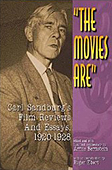
Books on the silent era of cinema.
Copyright © 1999-2025
by Carl Bennett
and the Silent Era Company.
All Rights Reserved. |
|
The Movies Are
Carl Sandburg’s
Film Reviews and Essays, 1920-1928
Edited by Arnie Bernstein
|

|
BOOK REVIEW
The Movies Are:
Carl Sandburg’s Film Reviews and Essays, 1920-1928
Edited and with historical commentary by Arnie Bernstein,
with an introduction by Roger Ebert
Lake Claremont Press : Chicago, Illinois : 2000
Trade Paperback Edition : ISBN 978-1893121054 : 399 pages
$17.95
Reviewed by Carl Bennett
|
|
Carl Sandburg, the poet and author of the unsurpassed biography of Abraham Lincoln, held down a modest day job as a journalist for Chicago’s Daily News newspaper from the late 1910s through the late 1920s. From 1920 through 1928, Sandburg was assigned the job of film critic for the Daily News. As can be judged from the writings reprinted in this volume, Sandburg wrote on the popular entertainment form both in earnest and with tongue planted firmly in cheek. For he respected the artistic efforts of many of the motion picture’s practitioners, but he also took delight in scoffing with his readers at the substandard work of others.
In this collection, assembled by Chicago writer Arnie Bernstein, Sandburg shows a willingness to keep an open mind when discussing the merits of what could be considered a nonstop parade of motion picture pap product. He discusses and judges a program-filling educational short film with the same respect as an acknowledged feature film classic. His balanced judgment imparts a feeling of trust in his pronouncements and gives the reader a historical perspective on the motion picture industry of the 1920s that transcends the disposable medium of the daily newspaper. Sandburg’s judgments of the 1920s are in sync with our late twentieth-century historical perspective on these films. There is not a sign of the smug isolationism of academia, nor of the sycophantic film criticism hack, whose undiscerning judgment is always colored by studio publicity.
The value of the volume at hand lies in its disected view of Carl Sandburg as journalist, his contemporary confirmation and validation of those films and filmmakers that are acknowledged as film greats today, Sandburg’s reportage on the responses of silent era movie audiences and of the theater-going experience, and his critical perspective on films that are presumed lost.
The contributions by editor Bernstein are of little value to the silent film enthusiast, being instead a guide to the reader whose principal interest is in Sandburg’s writings. On occasion Bernstein’s statements are suspect if not in outright error, but they mean little in his editorial role as a secondary voice behind that of Sandburg’s.
We found satisfaction in Sandburg’s critical views of the great films of the 1920s: those films generally accepted in all times and in all circles as great. We also enjoyed his terse rejection of director Cecil B. DeMille’s popular work in favor of brother William C. de Mille’s low-key achievements in dramatic direction, a not-uncommon argument in Sandburg’s time, nor in ours. And his preference for the formula westerns of Tom Mix, Hoot Gibson and Buck Jones paints a picture of Sandburg as a even-minded and folksy reviewer who appreciates the value of popular entertainments along side films of high intellectual and artistic value.
We have mixed feelings about this collection. The book could have benefitted a bit from better copy editing. The errant line breaks in Roger Ebert’s introduction and missed typographical characters in the main text bespeak of the volume’s computer-based production. And Bernstein could have been editorially held to task on some of his historical statements in his comments. But, overall, we find value in Carl Sandburg’s compact and sometimes hip-shot evaluations of the films of the greatest decade of the silent era. We recommend this book to both Sandburg and silent film enthusiasts.
|
|
This book has been discontinued and is . . .
|

|
|
|
|
Silent Era Home Page > Books > The Movies Are: Carl Sandburg’s Film Reviews and Essays, 1920-1928
|




































